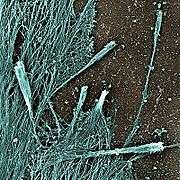Filopodia

Filopodia (also microspikes) are slender cytoplasmic projections that extend beyond the leading edge of lamellipodia in migrating cells.[1] They contain actin filaments cross-linked into bundles by actin-binding proteins, e.g. fascin and fimbrin.[2] Filopodia form focal adhesions with the substratum, linking it to the cell surface.[3] Many types of migrating cells display filopodia, which are thought to be involved in both sensation of chemotropic cues, and resulting changes in directed locomotion.
Activation of the Rho family of small Ras-related GTPases, particularly cdc42 and their downstream intermediates results in the polymerization of actin fibers by Ena/Vasp homology proteins.[4] Growth factors bind to receptor tyrosine kinases resulting in the polymerization of actin filaments, which, when cross-linked, make up the supporting cytoskeletal elements of filopodia. Rho activity also results in activation by phosphorylation of ezrin-moesin-radixin family proteins that link actin filaments to the filopodia membrane.[4]
Filopodia have roles in sensing, migration and cell-cell interaction.[1] To close a wound in vertebrates, growth factors stimulate the formation of filopodia in fibroblasts to direct fibroblast migration and wound closure.[5] In developing neurons, filopodia extend from the growth cone at the leading edge. In neurons deprived of filopodia by partial inhibition of actin filaments polymerization, growth cone extension continues as normal but direction of growth is disrupted and highly irregular.[5] Filopodia-like projections have also been linked to dendrite creation when new synapses are formed in the brain.[6][7] In macrophages, filopodia act as phagocytic tentacles and pull bound objects towards the cell for phagocytosis.[8]
Filopodia are also used for movement of bacteria between cells, so as to evade the host immune system. The intracellular bacteria Ehrlichia are transported between cells through the host cell filopodia induced by the pathogen during initial stages of infection.[9] Viruses were shown to be transported along filopodia toward the cell body, leading to cell infection.[10] Directed transport of receptor-bound epidermal growth factor (EGF) along filopodia has also been described, supporting the proposed sensing function of filopodia.[11]
References
- 1 2 Mattila PK, Lappalainen P (June 2008). "Filopodia: molecular architecture and cellular functions". Nat. Rev. Mol. Cell Biol. 9 (6): 446–54. doi:10.1038/nrm2406. PMID 18464790.
- ↑ Hanein D, Matsudaira P, DeRosier DJ (October 1997). "Evidence for a conformational change in actin induced by fimbrin (N375) binding". J. Cell Biol. 139 (2): 387–96. doi:10.1083/jcb.139.2.387. PMC 2139807. PMID 9334343.
- ↑ Molecular Cell Biology Fifth Edition Lodish, Berk, Matsudaira, Kaiser, Krieger, Scott, Zipursky, Darnell. pg. 821, 823 2004 by W.H. Freeman and Company.
- 1 2 Ohta Y, Suzuki N, Nakamura S, Hartwig JH, Stossel TP (March 1999). "The small GTPase RalA targets filamin to induce filopodia". Proc. Natl. Acad. Sci. U.S.A. 96 (5): 2122–8. doi:10.1073/pnas.96.5.2122. PMC 26747. PMID 10051605.
- 1 2 Bentley D, Toroian-Raymond A (1986). "Disoriented pathfinding by pioneer neurone growth cones deprived of filopodia by cytochalasin treatment". Nature 323 (6090): 712–5. doi:10.1038/323712a0. PMID 3773996.
- ↑ Beardsley, John (June 1999). "Getting Wired". Scientific American.
- ↑ Maletic-Savatic, M.; Malinow R. (June 1999). "Rapid Dendritic Morphogenesis in CA1 Hippocampal Dendrites Induced by Synaptic Activity". Science. doi:10.1126/science.283.5409.1923.
- ↑ Kress H, Stelzer EH, Holzer D, Buss F, Griffiths G, Rohrbach A (2007). "Filopodia act as phagocytic tentacles and pull with discrete steps and a load-dependent velocity". Proc. Natl. Acad. Sci. U.S.A. 104 (28): 11633–11638. doi:10.1073/pnas.0702449104. PMC 1913848. PMID 17620618.
- ↑ Thomas S, Popov VL, Walker DH (2010) Exit Mechanisms of the Intracellular Bacterium Ehrlichia" PLoS ONE 5(12) e15775. http://www.plosone.org/article/info:doi%2F10.1371%2Fjournal.pone.0015775
- ↑ Lehmann MJ, Sherer NM, Marks CB, Pypaert M, Mothes W (2005). "Actin- and myosin-driven movement of viruses along filopodia precedes their entry into cells.". J Cell Biol 170 (2): 317–325. doi:10.1083/jcb.200503059. PMC 2171413. PMID 16027225.
- ↑ Lidke, DS; Lidke, KA; Rieger, B; Jovin, TM; Arndt-Jovin, DJ (Aug 15, 2005). "Reaching out for signals: filopodia sense EGF and respond by directed retrograde transport of activated receptors.". The Journal of Cell Biology 170 (4): 619–26. doi:10.1083/jcb.200503140. PMC 2171515. PMID 16103229.